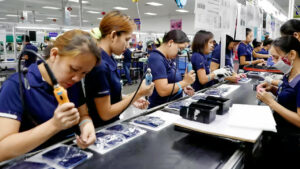By Beatriz Marie D. Cruz, Reporter
THE IMPACT of lower rates may not be reflected in the results of manufacturers this year, with Bangko Sentral ng Pilipinas policy remaining “tight,” according to analysts.
“Given that the Philippines’ monetary policy remains tight and borrowing costs are still high after its policy rate cut in August and considering lags between changes in monetary policy before they affect economic activities, we expect the central bank policy rate cut and expected rate cuts to have positive effects on the manufacturing sector in 2025 rather than this year,” Harumi Taguchi, principal economist at S&P Global Market Intelligence, said in an e-mail.
In August, the Philippines’ Manufacturing Purchasing Managers’ Index (PMI), which surveys around 400 manufacturers, was 51.2, unchanged from the July reading.
A PMI reading above 50 means stronger purchasing of raw materials, a leading indicator of future manufacturing activity. PMI of below 50 heralds a contraction.
Pantheon Macroeconomics Chief Emerging Asia Economist Miguel Chanco said it may take a few years before rate cuts have any real bearing on factory output.
“For one, monetary policy moves tend to filter through with a long lag. And second, the policy setting in the Philippines is still quite tight, even though rate cuts have entered the picture,” Mr. Chanco said in an e-mail.
Between May 2022 to Oct. 2023, the Monetary Board (MB) hiked borrowing costs by 425 basis points (bps) to tame inflation.
In its Aug. 15 meeting, the MB eased interest rates by 25 bps to 6.25%. The previous setting of 6.5% had been an over 17-year high.
“The real rate of interest — i.e., adjusted for inflation — is still very elevated at the BSP’s current setting, and will remain so if the Board pursues only gradual 25 bp adjustments,” Mr. Chanco said.
BSP Governor Eli M. Remolona, Jr. has cited the possibility of another 25-bp cut in the fourth quarter. Only two MB meetings are left for this year — Oct. 17 and Dec. 19.
A less restrictive policy environment is expected to fuel demand and spending, which would benefit industries like manufacturing.
Manufacturing activity in the medium term will be driven by the global demand for electronics. However, external demand may remain muted, Ms. Taguchi said.
According to S&P Global, the Philippines’ export sales in August fell for the first time since the year began, signaling weak foreign demand.
The Philippine Statistics Authority reported that exports of electronic products grew 2.5% to $23.88 billion at the end of July. This accounted for 56% of total exports for the period.
In July, electronic exports fell 11.9% to $3.25 billion and accounted for 52.1% of total exports for the month.
Ms. Taguchi also cited the Global Manufacturing PMI, which came in at 49.5 in August from 49.7 in July.
“These indicators suggest a notable upturn in external demand in the coming months is unlikely,” she said.
Southeast and East Asia supply more than 80% of the world’s semiconductors, the Asian Development Bank said earlier this year.
